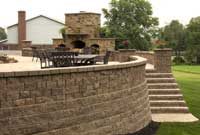Building a retaining wall is a great way to fortify uneven land in your yard, while simultaneously creating a beautifully engineered wall that accents your outdoor style. However, under prepared homeowners often run into problems after building their retaining wall. An ill-designed retaining wall can collapse under the pressure of the land if not constructed properly. Unfortunately, when a retaining wall fails, it typically happens slowly, so the builder is not aware of structural issues right away and they are met with a nasty surprise down the line.
The following excerpts from an article by This Old House explain the most common mistakes that homeowners make when building a retaining wall, as well as the best remedies for each of these situations. It is advised that anyone wanting to undertake a DIY retaining wall installation first understand the source of these common problems.
Engineering a Retaining Wall
A retaining wall can hold back a hillside and turn steep slopes into living space—if you pay attention to the basics Sure, retaining walls look like simple stacked stone, block, or timber. But in fact, they’re carefully engineered systems that wage an ongoing battle with gravity. They restrain tons of saturated soil that would otherwise slump and slide away from a foundation or damage the surrounding landscape. These handsome barriers also make inviting spots to sit, and can increase usable yard space by terracing sloped properties, something that is increasingly important as flat home sites become ever more scarce in many regions. Along with sloped landscapes where water runoff causes hillside erosion, ideal locations for a retaining wall include spots downhill from soil fault lines and where the downhill side of a foundation is losing supporting soil or its uphill side is under pressure from sliding soil.[…]
Safeguarding Against Three Common Failures
Retaining walls usually fail slowly. Common problems can often be fixed if you act quickly. You can also protect a new wall in the building process by safeguarding it against the three most common failures:
Blowout Failure
What happens: A load is added within 3 feet of the top of the wall. The wall leans out at the top and eventually tips over
What to do: Tell your landscape architect or engineer if a car or shed will be placed near the wall. The pro should then beef up the footer and increase the number of tiebacks or deadmen to add strength. Adding retrofit tiebacks is expensive and requires excavation, partial dismantling, and re engineering the wall
Wet-Soil Failure
What happens: Soil behind the wall gets saturated, causing hydrostatic water pressure and weight to topple the wall.
What to do: Replace native soil behind the wall with 3/4-minus or bank-run gravel for 2 feet. Line the inside base of the wall with 4-inch perforated tile drain on a gravel bed that slopes 1 inch for every 4 feet of run to carry water to daylight or a dry well. Topsoil should take up only the top 6 inches behind the wall.
Frost-Heave Failure
What happens: Retaining wall lacks proper drainage or a footer. Soil becomes saturated and freezes, heaving upward and breaking the wall apart.
What to do: Walls should rest on 3/4-minus or bank-run gravel, with the footer or wall base buried beneath the frost line (6 to 48 inches, depending on region). For deep frost, use concrete block rather than retaining wall to ground level, then build the retaining wall on that. Well-drained gravel behind and beneath the wall can substantially diminish frost heaving.
Now that you are aware of the problems that typically wrack a poorly engineered retaining wall, you can utilize the know-how to avoid these failures.
Be sure that the retaining wall is not located near anything heavy that could adjust the weight of the ground carried by the retaining wall. Harness it with tiebacks if you believe that this may occur. If you live in an area that commonly receives a lot of rain, it may be beneficial to replace the soil behind the wall. Finally, if you live in a place prone to frost, you should consider building the retaining wall on a foundation of concrete.
If you would like any more information on building a retaining wall or would like to purchase materials for your retaining wall project, please contact Camosse Masonry Supply.

